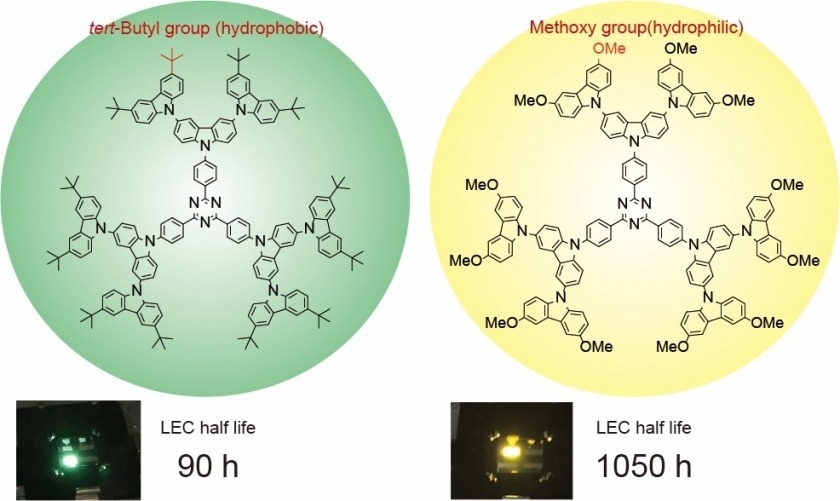In a study that could result in a new era in illumination, scientists from Japan and Germany have built eco-friendly light-emitting electrochemical cells using new molecules known as dendrimers integrated with biomass-derived electrolytes and graphene-based electrodes. Their results were published in the journal Advanced Functional Materials.
 Second-generation dendrimers with tert-butyl (left) and methoxy groups (right) applied to light-emitting electrochemical cells (LEC). The lifetime of LEC devices using dendrimers with hydrophilic methoxy groups (right) is more than 10 times longer than that of hydrophobic dendrimers. Image Credit: Kyushu University
Second-generation dendrimers with tert-butyl (left) and methoxy groups (right) applied to light-emitting electrochemical cells (LEC). The lifetime of LEC devices using dendrimers with hydrophilic methoxy groups (right) is more than 10 times longer than that of hydrophobic dendrimers. Image Credit: Kyushu University
Electroluminescence is the approach where a material repels light as a reaction to a passing electric current. Everything from the screen used to read this sentence to the lasers employed in advanced scientific studies is the outcome of the electroluminescence of different materials. Thanks to its necessity and ubiquity, it is only natural to invest in the study and development to improve this technology.
One such example of an emerging technology is 'light-emitting electrochemical cells' or LECs. They have been attracting attention because of their cost advantage over organic light emitting diodes, or OLEDs. Another reason for LECs popularity is their simplified structure.
Ken Albrecht, Associate Professor and Study Co-Lead Author, Institute for Materials Chemistry and Engineering, Kyushu University
Generally, OLED devices need the layering of several organic films, leading to costly and challenging production. On the other hand, LECs could be made using a single layer of organic film combined with an electrolyte and several light-emitting materials. The electrode that links everything together can also be built from cheap materials—contrary to the heavy or rare metals employed in OLEDs. Furthermore, LECs have lower driving voltage, which implies they take up less energy.
Our research teams have been exploring new organic materials that can be used in LECs. One such candidate are dendrimers. These are branched symmetric polymeric molecules whose unique structure has led to their utility in everything from medicine to sensors, and now in optics.
Prof. Rubén D. Costa, Research Team Lead, Technical University of Munich
Based on their previous study on building dendrimers, the study team started altering their materials for LECs.
The dendrimer we developed initially had hydrophobic, or water repelling, molecular groups. By replacing this with hydrophilic, or water liking, groups we found that the lifetime of the LEC device could be extended to over 1000 hours, more than 10-fold from the original. What makes it even better is that thanks to our collaboration with Dr Costa's team the device is very eco-friendly.
Ken Albrecht, Associate Professor and Study Co-Lead Author, Institute for Materials Chemistry and Engineering, Kyushu University
For a long time, Costa’s team in Germany had been working on building less expensive and more eco-friendly materials in light-emitting devices. Cellulose acetate, a common organic compound employed in everything from eyeglass frames and clothing fibers, is the one material they have been investigating.
“We used biomass derived cellulose acetate as the electrolyte in our new LEC device, and confirmed that it has the same long-life span. Moreover, we also found that graphene can be used as an electrode as well. This is a vital step toward making flexible light-emitting devices using environmentally friendly materials,” added Costa.
The team describes that although their study is potential, more studies are essential before the devices reach the market.
“The device we made here only illuminates in yellow, so we need to develop it to illuminate in the three primary light colors: blue, green, and red. Luminescence efficiency, how bright the light is, also needs work. Though thanks to our international collaboration, the future looks bright,” concludes Albrecht.
Journal Reference:
Cavinato, L. M., et al. (2023) Dendri-LEC family: Establishing the bright future for dendrimer emitters in traditional and graphene-based light-emitting electrochemical cells. Advanced Functional Materials. doi.org/10.1002/adfm.202302483.